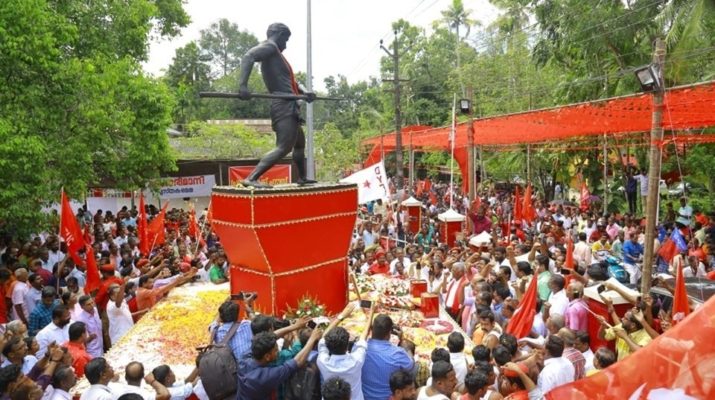Women party workers of menstrual age were banned from bearing torches, instead they were asked to carry flags on Punnapra-Vayalar commemoration day.

The memorial of the Punnapra-Vayalar uprising in Alappuzha. (Supplied).
The torch symbolises the indomitable uprisal of the communist spirit against oppressive forces. Carrying the torch during the anniversary of the Punnapra-Vayalar rebellion, an episode written in blood in the communist history of Kerala, is an honour for any Leftist in the state.
Yet, on 27 October this year, on the 77th anniversary of the Punnapra-Vayalar rebellion, a regressive chapter from the bygone feudal, misogynist past tainted the celebrations, sparking a debate over the present outlook of communists.
It was alleged that women of menstrual age were barred from carrying the torch since they were considered impure.
In the long and tumultuous history of Kerala’s communist movement, the Punnapra-Vayalar uprising is seen as a watershed moment that continues to inspire generations.
In October 1946, poor coir industry workers of Alappuzha in the then princely state of Travancore, rose in protest against Sir CP Ramaswamy Iyer, the then Diwan.
They agitated for their rights, apart from demanding the kingdom to join the Indian Union, rejecting Iyer’s proposal to keep Travancore as an independent, sovereign entity.
While Iyer fought for an independent Travancore, the communists saw it as an attempt to stand with American and British interests.
They agitated under the slogan “American Model Arabikadalil” — loosely translated as the US model will be tossed into the Arabian Sea that forms the western border of the state. The agitators included the now centurion, former chief minister VS Achuthanandan.
When peace talks fell through, coir workers and other labourers armed with varikunthams (spears made out of areca nut trees) clashed with the then-Travancore army, backed by the British forces with much fire power.
Blood flowed like a river when human flesh clashed with metal and firearms. Exact counts are still unknown, but estimates imply that Travancore and British forces slaughtered a few hundred labourers, triggering widespread criticism around the world.
The martyrdom of Punnapra-Vayalar fighters turned the rice fields scarlet, and communist parties bloomed on those fields and gained an upper hand in Kerala politics.
Iyer fled Travancore after an assassination attempt by socialist KCS Mani, prompting the then maharajah, Chithira Thirunal Balarama Varma, to join the Indian Union.
Later, the communist party used the rebellion to strengthen its base among the coir, beedi, and agricultural workers, a major segment of voters who had become disillusioned with the Congress’s anti-proletariat rhetoric.
The rebellion also became a part of the communist folklore.
Every year on 27 October, one of the most notable activities commemorating Punnapra-Vayalar Martyrs’ Day is the lighting of a flame at Valiyachudukad in Punnapra, where over 1,000 martyrs were burned after being butchered by the army in 1946.
Despite the split of the Communist Party of India in 1964, both the CPI and the CPI(M) have been jointly observing the Martyr’s Day.
As usual, top leaders from both parties reached the Valiyachudukad — or the vast burial ground — and lit torches before passing them to athletes who were to carry them to Vayalar, a short distance away, to light the memorial lamp.
Senior CPI(M) leaders TM Thomas Isaac and G Sudhakaran were among those leaders who addressed the event.
Almost a fortnight after the event, the left circles in Alappuzha were abuzz with talk about the Martyrs’ Day observance. Many questioned the progressive leanings of the Left parties and their advocacy of gender equality.
A large number of young CPI and CPI(M) leaders requested their state leaders to intervene and take action against individuals who prevented women cadres of menstrual age from carrying the torch in a procession from Punnapra to Vayalar.
Cultural and religious taboos on menstruation are prevalent in Hindu temples throughout Kerala, and the ban on women’s entry at Sabarimala, the forest abode of the celibate god Ayyappan, has sparked national debate, at times requiring the intervention of the Supreme Court.
The temple is out of bounds for women of menstrual age, defined as those aged between 10 and 50.
However, enraged young members of both communist parties claimed that it was the first time that such a revolutionary movement employed the same taboo to prevent young women, mostly athletes from party-affiliated families, from carrying the torches that reflect the legacy of sacrifices meant for social reformation and equality.
According to highly placed LDF sources in Alappuzha that South First spoke to, it was a senior woman Area Committee member of the CPI(M) who barred the young women athletes from carrying the torches, citing menstruation-related purity. Other leaders present, did not object, they said.
The woman leader allegedly wanted to protect the purity of the torches and instructed the girls to carry the flags of both parties.
As a result, carrying the torchlights became an all-male event this year. The women joined them, holding red flags.
In the previous years, party leaders encouraged women to carry torches.
The matter came to light after the CPI’s Ambalapuzha regional secretary, EK Jayan, and another CPI leader, H Subheesh, raised it before the state leaders of both parties.
The local language media also published news articles, triggering a heated debate over Hindu purity obsessions hijacking Marxist political activities.
When contacted, the leaders of both left parties told South First that they would not discuss the subject until the state leadership intervened.
CPI(M) district secretary sought to play down the controversy.
Speaking to South First, he said the torches weighed more than four kg and were difficult for women to carry.. The CPI district leadership declined to comment.

May 02, 2024

May 01, 2024

Apr 29, 2024

Apr 28, 2024

Apr 25, 2024

Apr 25, 2024